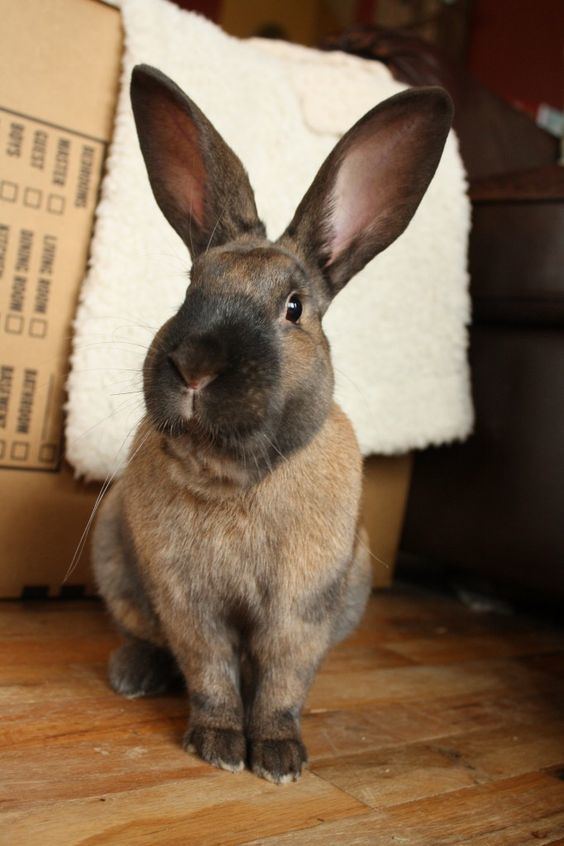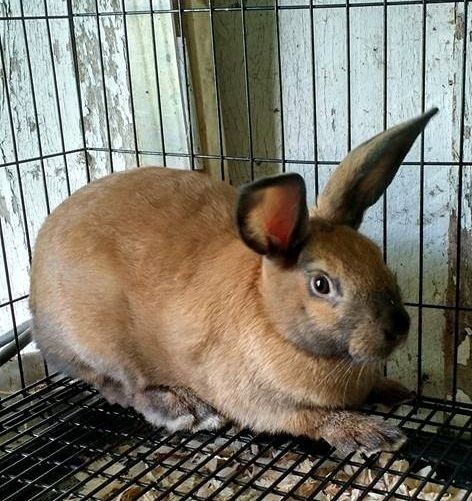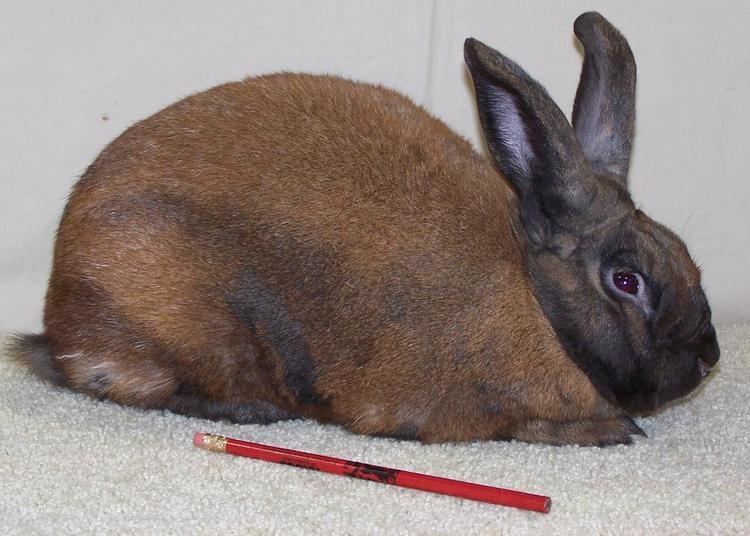Scientific name Oryctolagus cuniculus | Rank Breed | |
 | ||
Similar Havana, Palomino rabbit, Beveren, Himalayan rabbit, Lilac rabbit | ||
Cinnamon rabbits
The Cinnamon rabbit is a breed of domesticated rabbit that was created in 1962. Its russet color fur characterizes the breed, giving the rabbit its “cinnamon” title. The breed’s amiable nature makes it ideal for pet owners. However, because the Cinnamon is a relatively new breed which makes it moderately hard to find; therefore, searching to obtain one is to be expected.
Contents
- Cinnamon rabbits
- Cinnamon rabbit moving up and down stairwell
- History
- Appearance
- Lifestyle Behavior
- Food Housing
- Uses
- Meat
- Fur
- Show
- Pets
- ARBA Standards
- References
Cinnamon rabbit moving up and down stairwell
History
The Cinnamon rabbit was actually created accidentally by two children, Belle and Fred Houseman, during the Easter season of 1962 in Missoula, Montana. After crossbreeding their Chinchilla doe and their New Zealand buck, the children’s father, Ellis Houseman, let the children keep one crossbred buck. After joining their local 4-H group, the children were given a Checkered Giant doe and a crossed Californian doe. After mating the crossed buck with each doe, the Californian doe produced one russet-colored bunny in its litter and the Checkered Giant eventually produced two bunnies with this russet-colored fur (one doe and one buck.) Ellis Houseman believed that only purebred rabbits should be kept for show, but he reluctantly allowed his children to keep the pair of russet-colored bunnies from the Checkered Giant’s last litter. The children mated this pair together, and 70 percent of the litter had this new auburn shade of fur, which they began calling Cinnamon. Ellis noticed this new color and the fur’s excellent sheen, and proceeded to present the rabbits to J. Cyril Lowett, Oregon ARBA Judge and board member at the time. Lowett declared that there was a strong possibility of the rabbits’ ability in becoming an official breed, as there was no other breed like them in the United States. There are a couple of requirements needed for an unrecognized breed of rabbit to become an official breed according to ARBA. The Housemans needed to have their rabbits “passed” by three different ARBA conventions. The Housemans first took their Cinnamon's to the ARBA convention in Calgary, Canada in 1969. The Cinnamon's were immediately approved, so the family sent them to the 1970 convention in Syracuse, New York. Unfortunately, the family could not attend and therefore sent the rabbits to Syracuse by air freight. During this trip the rabbits contracted a virus that sickened and even killed some of them, and they were not passed by the convention due to their poor form and condition. In 1971 the Housemans continued their efforts for the Cinnamons to become an official breed, and the family took the rabbits to the 1971 convention in Albuquerque, New Mexico. Again there were some obstacles- the family hit a severe storm and had to abandon their trailer, and a dog broke into their rabbitry, killing three of their best does. However, the rabbits managed to pass the convention with good comments. The family finally reached their goal in 1972, when the rabbits passed their third convention in Tacoma, Washington and were officially recognized and accepted by the ARBA’s Book of Standards.
Appearance

The Cinnamon rabbit tends to weigh between 8.5 and 11 pounds, or between 3.9 and 5 kilograms. The rabbit is very striking, with rust or ground cinnamon coloring and a uniform gray ticking across the back. The rabbit has a smoky grey coloring on its sides and a dark underbelly, with an orange under-coloring all over. The rabbit has distinct rust-colored spots inside its hind legs, and these spots often appear on its feet and face. The hind legs, feet, and face tend to be generally darker than the rest of the body. A butterfly effect marks the nose and small circles around each eye are present. The Cinnamon is medium in length and has a commercial body. The rabbit’s hips are deeper and wider than its shoulders, its head is proportionate to its body, and its ears are erect.
Lifestyle & Behavior
The Cinnamon is very adapted to pet use, and it’s large enough for youth who want and can also handle a larger sized rabbit without being one that’s too giant-sized to handle. The Cinnamon is a hardy breed- it tends to live between 5 and 8 years- and it is laidback, fairly calm, well disposed, and enjoys attention. Its coat is short and easy to care for, so weekly grooming with a slicker brush should be adequate for the majority of the year. However, biweekly grooming may be necessary during the shedding season. The Cinnamon, like any breed of rabbit, will benefit from a well-balanced diet, plenty of room to exercise, various toys to chew on, and plenty of time spent with its owner.
Food & Housing

The Cinnamon Rabbit required a well balanced diet to remain healthy. Grass hay, cecotropes, and green foods are staples in the diet of a domestic rabbit. Grass hay can consist of timothy, meadow, oat, rye, barley or Bermuda grasses. If grass hay is not available, legume hay is an acceptable alternative. Legume hay is very rich with nutrients which a domestic rabbit does not need; therefore, it should only be an alternative. Flowers, fruits and vegetables are acceptable to feed a domestic rabbit but only in small amounts, not as an entire meal. Water should be constantly available for a rabbit. All rabbits should be raised in hutches that have 1/2" x 1/2" or 1/2" x 1" galvanized wire mesh bottoms. This will allow their droppings to fall through. If they stay on any other type of surface that allows their feces to accumulate, it will cause disease because of the bacterial and possible parasitic build up. The cage should be tall enough for the rabbit to stand on its back legs without hitting its head. The cage should be resistant to chewing, as well as big enough for the rabbit to have a rest area and a place to hide. If the rabbit is kept in a cage for the majority of the time, it should be taken out a few hours of the day for exercise to avoid health problems. Bedding such as a pelleted litter is also something that is beneficial for the rabbit’s housing.
Uses

Rabbits tend to be bred for one of four things: meat, fur, show, or pet use. The Cinnamon rabbit is referred to as the “All-Purpose Rabbit” because it fulfills all four of these purposes.
Meat
Cinnamons were originally bred as meat rabbits. Of the four parent breeds of the Cinnamon, the New Zealand, Checkered Giant and Californian are largely used meat rabbits (the New Zealand is the most popular meat rabbit in the country, followed by the Californian) giving the Cinnamon a high potential as a meat rabbit as well.
Fur
Cinnamons have been bred to achieve a specific coloring, which does not vary much between rabbits of the breed. This unique and appealing color makes it an ideal fur rabbit, but because it is a rare breed it is not used often.
Show
Cinnamons have become a popular breed in competitive showing as well. Some experienced rabbit breeders enjoy the challenge of breeding the cinnamon rabbit because acquiring them is difficult due to their low numbers. However, the cinnamon is also suited for the amateur shower who isn’t interested in breeding. The rabbit itself is a great specimen for show because it is a commercially designed rabbit with good musculature and size.
Pets
As pets, Cinnamons are a great option. They require a balanced diet, but little grooming and care. They are large rabbits, making them too difficult for a small child to handle on their own, which keeps both the rabbit and child from injury. The Cinnamon’s large size and sturdiness also allows older children to handle the breed without fear of injuring it. The naturally calm temperament of a Cinnamon suits families who are looking for a pet rabbit because the rabbits enjoy human attention.
ARBA Standards
The American Rabbit Breeders Association (ARBA) sponsors sanctioned rabbit shows by breeders’ clubs. The ARBA issues their Standards of Perfection that can be purchased by potential showers which details the qualifications for each. Cinnamons are rated on a 100-point scale. 58 points on body type, looking for a good, medium sized body with smooth bone structure and good filled in flesh. The head is awarded up to three points, and the ears are given two. 11 points can be awarded for coloring and coat, which gives a well-bred Cinnamon an edge in competition from its unique coloring. Another 11 points from markings and color variations can be awarded, and Cinnamons again can have the advantage here with varying shades of rust and brown on the body and belly, and a lighter gray dusting along the back.
